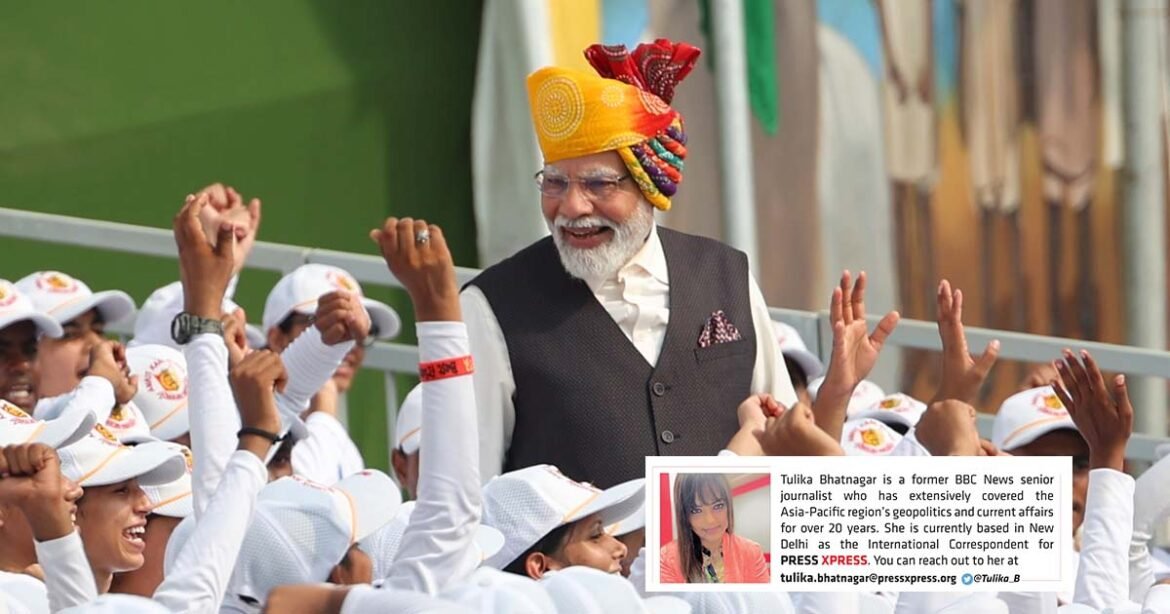India Prime Minister Narendra Modi on Tuesday morning delivered his 10th Independence Day address in a pivotal moment as he laid out not only his party’s accomplishments and agenda but also made a case for his leadership ahead of the 2024 general election.
Unlike his first year in office in 2014, when Modi described himself as “an outsider to Delhi” and feeling “quite isolated from the elite class” – the prime minister now controls both Houses of the Parliament, with his ruling coalition dominating more than 60% of the total seats in the Lower House and over 45% in the Upper House.
PM Modi stressed the potential, performance, and plans of his party for national progress, reminding voters of his accomplishments.
You can also read: ‘Continuity in strong Indo-Bangla ties is my biggest takeaway’
He also flaunted a growing economy through infrastructure and manufacturing inroads in his nationally televised address, stressing the fact that India was now a significant player on the world platform.
Economic high
PM Modi reflected on the economic progress and global achievements made under his watch.
He spoke in detail about how his government had lifted over 130 million people out of poverty.
“When poverty decreases in a country, the power of the middle class increases considerably,” he said. “In the next five years, I promise India will be among the top three economies in the world.”
His remarks came in light of the International Monetary Fund (IMF) recently projecting a growth rate of 6.1% for India in 2023, and the Indian central bank saying it expects 6.5% GDP growth in 2023-24, putting the country on track to become the third largest economy in the world after the US and China.
India’s $3.5 trillion economy is currently ranked fifth largest in the world behind the US, China, Japan, and Germany. Last year, it surpassed the United Kingdom’s economy.
PM Modi also said that in 2047, when India marks 100 years of independence, the country will be a developed nation.


Election confidence
“Next year, on August 15 from this same Red Fort, I will list out the progress achieved by the nation,” he said. “And sing paeans to your strength, your resolve and your success with greater confidence!”
PM Modi has left no doubt that he believes he has more work to do after returning as prime minister in 2024.
He laid out plans for the future using an inclusive growth model based on the principle of “Sarvajan Hitay, Sarvajan Sukhay”, or “Welfare for all, Happiness for all”.
In more specific terms, the speech outlined key elements for growth by focusing on community-driven development, providing funds to artisans and small businesses through the Vishwakarma Yojana scheme, and driving women-led development, including plans to spend $133 billion on women self-help groups. He also outlined plans for the development of India’s border villages and speeding up investments in renewable energy.

Addressing the gathering at the historic Red Fort in Delhi and the country’s citizens, PM Modi slipped in digs at the opposition parties, such as when he talked about how dynasty politics had weakened the country.
“What is that disease? Dynastic politics,” he said at one point.
At another point, he said corruption under the Congress rule was “like termites” having “completely hollowed out the systems of the country and its capabilities”.
There is so much more to do, he said, calling for more reforms and laying emphasis on strengthening the “national character”.
Giving the example of other, developed countries, whose catalytic growth agent was the building of a national character, PM Modi said, “We have to move forward by giving more emphasis to the national character”.
He said the mantra for “One India, Supreme India” can only be achieved if the collective national character is “majestic, hardworking, courageous, and sharp”.
PM Modi was likely confident that the public liked what they heard about his accomplishments, and he might be right: the Mood of the Nation poll by leading polling agency C-Voter found out earlier this year that 72% are happy with the prime minister’s performance and nine years into power, Narendra Modi’s popularity remains indented.
Unlike his first year in office in 2014, when Modi described himself as “an outsider to Delhi” and feeling “quite isolated from the elite class” – the prime minister now controls both the Houses of the Parliament, with his ruling coalition dominating more than 60% of the total seats in the Lower House and over 45% in the Upper House.



